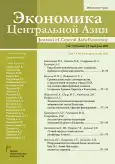The smart city and the brain drain (on the example of Almaty)
- Authors: Sagandykova S.S.1, Omarov G.B.1, Ananev T.V.1, 1
-
Affiliations:
- International University of Information Technology
- Issue: Vol 7, No 2 (2023)
- Pages: 151-170
- Section: Articles
- URL: https://journals.rcsi.science/2542-0607/article/view/146583
- DOI: https://doi.org/10.18334/asia.7.2.117607
- ID: 146583
Cite item
Abstract
About the authors
Saule Shaydullovna Sagandykova
International University of Information Technology
Email: s.sagandykova@iitu.edu.kz
Ассоциированный профессор кафедры экономики и бизнеса, кандидат экономических наук, доцент, PhD
Galym Burkitbaevich Omarov
International University of Information Technology
Email: email@example.com
кафедра экономики и бизнеса
Timur Vladimirovich Ananev
International University of Information Technology
Email: email@example.com
кафедры экономики и бизнеса
Email: email@example.com
References
- The concept of the migration policy of the Republic of Kazakhstan for 2023 – 2027. [Электронный ресурс]. URL: https://www.gov.kz/memleket/entities/enbek/documents/details/383914?lang=ru (дата обращения: 11.01.2023).
- Smart City Index 2021. A tool for action, an instrument for better lives for all citizens. [Электронный ресурс]. URL: https://imd.cld.bz/Smart-City-Index-2021 (дата обращения: 15.01.2023).
- What is a Smart City? – definition and examples. [Электронный ресурс]. URL: https://www.twi-global.com/technical-knowledge/faqs/what-is-a-smart-city (дата обращения: 27.01.2023).
- Salt J. Directorate for Education, Employment, Labour and Social Affairs - International Migration Unit - Occasional Papers N°3 International Movements of the Highly Skilled. OCDE/GD(97)169. Paris. [Электронный ресурс]. URL: https://www.oecd.org/migration/mig/2383909.pdf (дата обращения: 30.01.2023).
- Спиридонова Н. В., Судова Т. Л. Миграция человеческого капитала как фактор устойчивого развития // Проблемы современной экономики. – 2019. – № 3 (71). – c. 146–150.
- Bureau of National Statistics of the Agency for Strategic Planning and Reforms of the Republic of Kazakhstan. [Электронный ресурс]. URL: https://www.gov.kz/memleket/entities/stat?lang=en (дата обращения: 14.01.2023).
- INSEAD (2022) The Global Talent Competitiveness Index 2022: The Tectonics of Talent: Is the World Drifting Towards Increased Talent Inequalities? Fontainebleau, France. [Электронный ресурс]. URL: https://www.insead.edu/sites/default/files/assets/dept/fr/gtci/GTCI-2022-report.pdf (дата обращения: 25.01.2023).
- The 2021/2022 Human Development Report. [Электронный ресурс]. URL: https://hdr.undp.org/content/human-development-report-2021-22 (дата обращения: 11.02.2023).
- Chai Keong Toh Smart city indexes, criteria, indicators and rankings: An in‐depth investigation and analysis. 13 July 2022. IET Smart Cities. [Электронный ресурс]. URL: https://ietresearch.onlinelibrary.wiley.com/doi/epdf/10.1049/smc2.12036 (дата обращения: 9.02.2023).
- «Утечка мозгов» как глобальное явление. Причины и последствия. Электронная публикация: Центр гуманитарных технологий. 05.04.2008. [Электронный ресурс]. URL: https://gtmarket.ru/library/articles/1653 (дата обращения: 24.01.2023).
- Global Data Lab. [Электронный ресурс]. URL: https://globaldatalab.org/shdi/shdi/ (дата обращения: 18.01.2023).
- Садовская E. Репатриация казахов из Китая // Demoskop Weekly. – 2015. – № 629 – 630.
- The population of Afghanistan. Country meters. [Электронный ресурс]. URL: https://countrymeters.info/ru/Afghanistan#population_2023 (дата обращения: 18.01.2023).
- Nikiforova E., Brednikova O. On labor migration to Russia: Central Asian migrants and migrant families in the matrix of Russia’s bordering policies // Political Geography. – 2018. – № 66. – p. 142–150.
- С начала года статус кандаса получили почти 18 тысяч человек. Kapital.kz. 2022.12.2012. [Электронный ресурс]. URL: https://kapital.kz/gosudarstvo/111206/s-nachala-goda-status-kandasa-poluchili-pochti-18-tysyach-chelovek.htm (дата обращения: 25.01.2023).
Supplementary files








